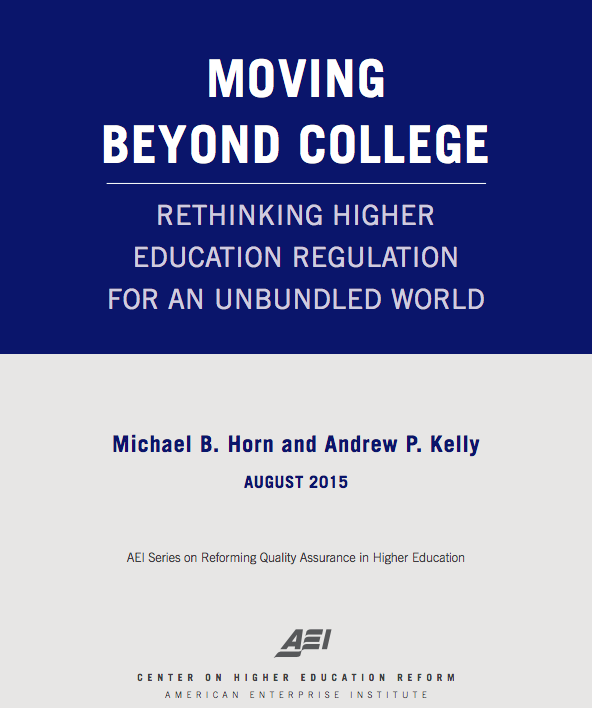AEI Series on Reforming Quality Assurance in Higher Education
August 2015
EXECUTIVE SUMMARY
In the face of increasing costs and lackluster outcomes, traditional higher education is under increasing pressure to prove its value proposition. Meanwhile, new providers have “unbundled” the components of a postsecondary degree or certificate by offering stand-alone courses or sequences of courses, targeted job training, and assessments and certifications, often at much lower cost than existing institutions. These models cannot deliver all of what a traditional college or university does, but they can provide affordable, flexible, and customizable opportunities to learn.
As unbundling in higher education has accelerated, reformers have asked whether there is a role for federal aid dollars to play in facilitating access to these new opportunities. This, in turn, has raised questions as to whether the traditional approaches to regulating postsecondary education at the state and federal level are well suited to this new ecosystem. The entire regulatory system that governs postsecondary education— from financial aid policy to quality assurance to data collection and transparency—is premised on the institution as the key unit of analysis. Students who wish to access federal aid must be enrolled in degree- or certificate-granting programs at accredited colleges. Shorter-term training, sequences of courses, and prior learning assessment are typically held at arm’s length.
That the existing quality assurance system is ill-designed for this new world is abundantly clear. Less clear, however, is what should replace it. Simply lowering barriers to entry such that federal money can flow to a much wider array of providers would invite waste, fraud, and abuse. Thus, this policy brief outlines potential regulatory approaches and tools—many of which would work well in combination—that policymakers could use to facilitate access to this unbundled market while protecting consumers and taxpayers.
First, we discuss a series of reforms to the federal approach to quality assurance: increased transparency, a chartering model, and an outcomes-based accountability framework. For instance, policymakers could require innovative providers to opt in to additional data collection and reporting to be allowed access to federal aid. A chartering model would empower new, independent authorizers to govern market entry and hold providers accountable over time. Finally, reformers could also develop an outcomes-based approach focused on value that measures labor market outcomes and student satisfaction relative to an institution’s total expenditures.
The second section presents a couple of ways that policymakers could rely on private financing to bear some of the risk in quality assurance. For instance, new providers could be required to put up private capital to become eligible for federal aid. In addition, the government could employ a “pay for success” model— perhaps through a social impact bond—in which providers could be reimbursed if they reach agreed-upon outcome benchmarks. Lastly, at the individual level, the government could create space for private financing, such as income share agreements, that could help students access worthwhile options.
The third section argues that policymakers might also choose to wait for the market to mature on its own and let consumer demand and competition drive innovation. Market pressure, not government, may better facilitate the emergence of a high-quality unbundled market, though this pathway may limit access for students who lack the necessary resources.
We do not recommend one approach over the others but instead suggest that policymakers should carefully experiment with them. Such experimentation can lay the groundwork for a more comprehensive reform to the entire federal aid system as we learn more about what approaches prove successful.

Download the full policy brief, published by the American Enterprise Institute




